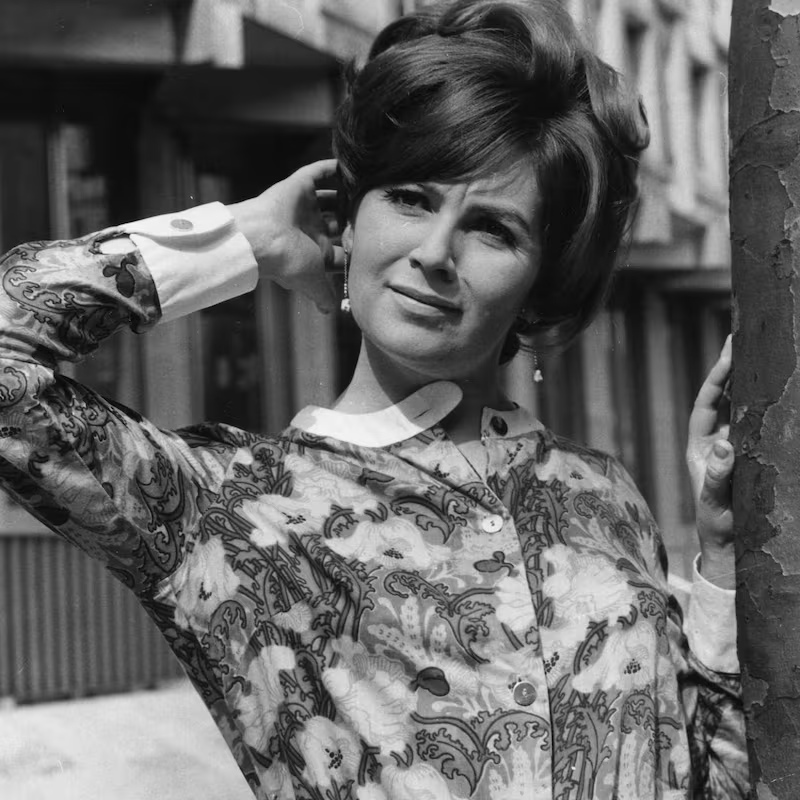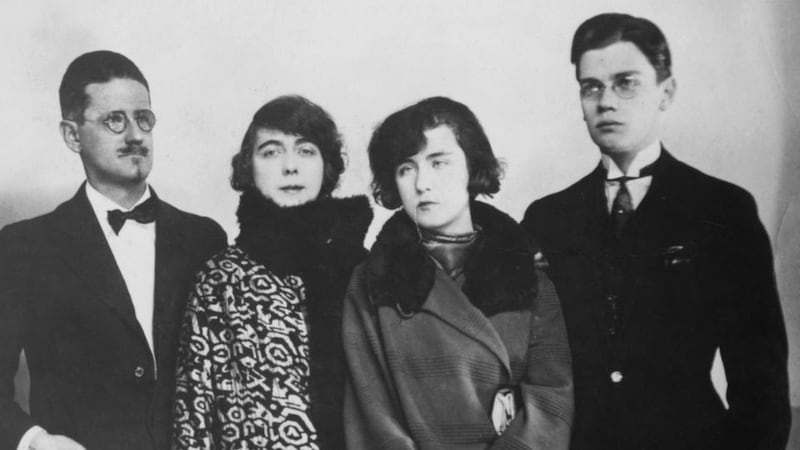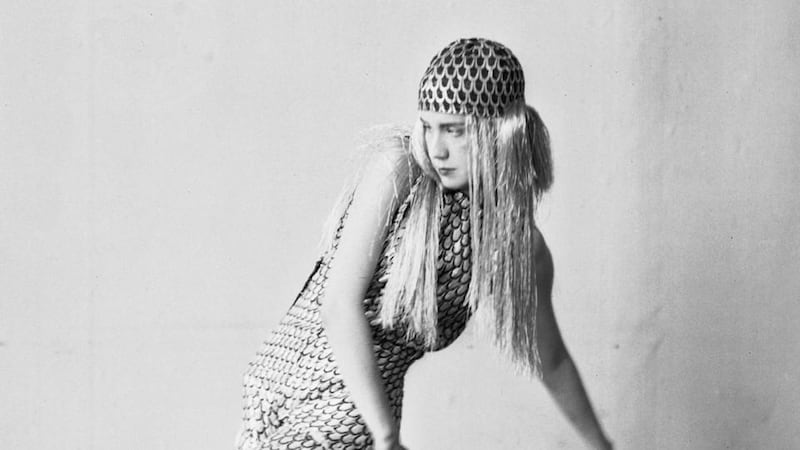A package from London arrives on my doorstep in Paris this summer, soon after I make an appointment to interview Edna O’Brien about her new play, Joyce’s Women. The author has tied its loose pages together with a grey satin ribbon stained with purple ink.
O’Brien’s 1960 novel Country Girls is a monument of modern Irish literature. She went on to write dozens more books. She is a woman whose love stories, real-life and imagined, end badly.
Travelling on the Eurostar, I listened again to her 2007 interview with Desert Island Discs. “I don’t think I know or have ever learned the game of men and women,” she said. “It’s like a dance that I cannot learn.” Then aged 77, she nonetheless hoped to fall in love again.
O’Brien calls the small house in a posh area of southern London where she has lived for more than 35 years her Doll’s House, in honour of Ibsen. She laments the fact that she still struggles to pay the rent.
READ MORE
We sit at the kitchen table, beneath the eagle-eyed gaze of Samuel Beckett, while she gathers the strength to climb the stairs to her book-lined study. She will turn 92 on December 15th and is frail and exhausted by successive rewrites of her play.
Joyce’s Women will run at the Abbey Theatre in Dublin until October 15th. “I hope I don’t get booed off the stage,” she says. Her play is brilliant, I tell her. The audience will love it. “The writer never knows,” she says tremulously. “Unless you are a publicity hound, unless you mix among people. I know many writers who ruined, harmed their talents by becoming social, social, social. This is tosh ...”
“But you had a period in your life ...” I interrupt her.

O’Brien once owned a six-bedroom house at 10 Carlyle Square in Chelsea, where she entertained everyone who was anyone in literature or entertainment: Marlon Brando, Richard Burton, Jane Fonda, Paul McCartney, VS Naipaul, Jackie Onassis, Vanessa Redgrave, JD Salinger ... Her sons, Carlo and Sasha, ferried champagne up from the cellar.
“I had a reckless period,” O’Brien admits. “Do I regret it? No, because it was part of the trip.”
Like her greatest hero, James Joyce, O’Brien did not manage money well. She stopped writing for 10 years and lost her house. Now living in genteel poverty, she dresses well, in a patterned black and white silk dress and black cardigan, despite the summer heat. The trip to the hairdresser is her main extravagance, her honey-coloured hair her crowning glory.
She has many things in common with Joyce, I suggest.
“A stick!” she laughs, waving her walking stick in the air.
She admits to a similar upbringing to Joyce’s, dominated by Catholicism and alcoholic fathers. Their books were banned but later regarded as seminal texts. Both engaged in an endless quest for le mot juste. Despite spending her adult life in exile, O’Brien could say, like Joyce, “People ask why I never went back to Dublin and my answer is, ‘Have I ever left it?’”
I learned more from Joyce than anyone else in the world... I learned how to put one word after another and make sense of them
— Edna O'Brien
O’Brien tells Joyce’s story through the eyes of his wife, Nora Barnacle, daughter Lucia, mother May, brother Stanislaus, his long-suffering benefactor Harriet Shaw Weaver, and Martha Fleischmann, who was briefly his mistress.
The protagonists recreate Joyce’s life while they wait for his death in Zurich. Scenes are threaded together by ballads sung by Zozimus, the Blind Bard of the Liberties in early 19th century Dublin.
O’Brien has so thoroughly absorbed Joyce’s speech patterns that it is often difficult to distinguish between quotes from his writings and her words. Not pastiche. Osmosis.
“I learned more from Joyce than anyone else in the world,” O’Brien says. “I learned how to put one word after another and make sense of them. Beckett was once asked what made Joyce such a great writer and he replied, ‘He made the words do the work’.”
With a fervour reminiscent of Joyce’s first sighting of Nora Barnacle, O’Brien recalls her first encounter with his prose. She was training to become a pharmacist, though she wanted to be a writer. In a Dublin bookshop on her day off, she happened upon a copy of Portrait of the Artist as a Young Man.
“I read only a paragraph before realising that everything else I had read before, except perhaps the gospels and some ancient myths, everything else was third rate. What I ate and drank from his writing was to get to the true pith of not only each scene, but each little moment in each little life. Nothing extraneous and yet nothing absent.”

O’Brien whispers as if in confidence: “He taught me some secret thing, and I don’t know what it is. No other writer has taught me what Joyce taught me, which is to get to the pure, to the thing that hurts, to the thing that moves ... Even Faulkner, whom I worship, no one else taught me that. No one ever will. It was like a huge, miraculous gift.”
She breaks the dramatic spell with laughter. “He would be very pleased with the miraculous word ... I would love to have met him, preferably at evening time, with a glass. And would I have asked him a question? I am not sure.”
Nora was funny. She was spry and, in a sense, she stood up to him. She didn’t kneel at his feet or call him the great master
The infernal love triangle between Joyce, Nora and their gifted but troubled daughter Lucia lies at the heart of Joyce’s Women.
The bond between James and Nora, a hotel chambermaid from Galway who lived in poverty and exile for him but never read his books, remains a mysterious alchemy of sexual attraction and almost metaphysical mutual dependence. In James & Nora, A Portrait of a Marriage, O’Brien called it “forever mingling the genitalia and the transubstantial”.
Joyce slept with Nora’s glove under his pillow and sent her magnificent love letters. “I was his wild flower of the rain-drenched hedges, made beautiful by moonlight, his soul trembling beside mine ... I was the other half of Ireland,” she recalls.
“Jim is my child ... Jim is my life,” Nora says in the play. “I learned to roll Turkish cigarettes to keep hunger at bay. If I gave him a stern look, he would put a note under the teapot begging forgiveness”.
Joyce said that he wanted to be a woman. “He called himself ‘a womanly man’,” O’Brien says. She believes that his desire to experience womanhood was part of what attracted him to Nora. “His overwhelming impulse towards Nora Barnacle was to do with the possessing of her womanness, body and soul, her thinking, her sexuality. He wanted to absorb every bit of her. I don’t think even she understood the mystery and astonishment of her power over him.”
Joyce was prone to getting “maggoty drunk”, as his brother Stanislaus put it. “When he had a second bottle, he wanted a third bottle. And Nora tried to stop him,” O’Brien says. She quotes Charmian, Cleopatra’s lady in waiting in Shakespeare. “Cross him in nothing” was Nora’s attitude.
“Nora could stand up to him about whether they would buy a carpet when they got into the money, but she never contradicted his deeper intent,” O’Brien says. “She read some proof pages of Ulysses and called them ein schwein, a pig”. When the first two copies of Ulysses reached Paris on the train from Dijon, Joyce gave one to Nora as a gift. “Nora proceeded to sell it, half in jest, to his friend Arthur Power. Nora was funny. She was spry and, in a sense, she stood up to him. She didn’t kneel at his feet or call him the great master or say, ‘Have you read my husband’s masterpiece?’ she was much too shrewd for that.”
Joyce from the very start, as is often the case with fathers, favoured his daughter. As years went on, his love and daily habits, his affections for Nora, were certainly sexually dampened or lessened...
It was not an easy marriage. Nora ignored Joyce’s penchant for prostitutes and sometimes locked him out when he came home drunk. She had no interest in cooking or housekeeping. In the play Stanislaus recounts his arrival in Trieste: “Pots and pans all over the floor, chairs stacked on top of one another, broken crockery, Giorgio spurting water from a pistol and little Lucia sitting on the floor combing her hair for nits which she called eggs.”
Genius and parenthood make poor bedfellows, O’Brien says. When James and Nora were “young, besotted, bohemian and chaotic” they were “entangled with each other but not in a normal marital way like dinner at six or a walk in a park on Sunday. There would be none of that codology”.
The play contains only one allusion to Giorgio, the Joyces’ first child. “My brother runs with the smart crowd, drinking daiquiris, chasing rich divorcees,” Lucia tells her father.

“Joyce from the very start, as is often the case with fathers, favoured his daughter,” O’Brien explains. “As years went on, his love and daily habits, his affections for Nora, were certainly sexually dampened or lessened. That’s no surprise to anyone, biologically, and this budding, dancing, gifted creature Lucia entered more into his life and thinking. Nora was jealous.”
O’Brien categorically rejects rumours of incest between Joyce and Lucia. “B*****ks!” she exclaims. “Do you know why I say that with such certainty? He loved and revered her too much. He revered his daughter. He revered her mind. He thought she was part of his mind, which she was, in a sense”.
Unlike Nora, Lucia was interested in Joyce’s writing. She recites from Portrait of the Artist and Ulysses in the play. In a haunting scene she and Joyce speak alternating lines from the Anna Livia Plurabelle section of Finnegans Wake. Joyce is amazed, for he has not yet written them.
Poetic license, but also, I think poetic truth. It is not exaggerated. It is not gratuitous. She threw a chair at her mother
Lucia was the inspiration for Anna Livia, the river woman. “My daughter. She will drown me with her eyes, with her hair, lank coils of seaweed hair around my heart,” Joyce says on his deathbed, while father and daughter long heartbreakingly and in vain to see one another.
Joyce refused to recognise Lucia’s increasingly dangerous behaviour. “Tantrums, wild fits of rage, setting fire to the kitchen table and often disappearing for days,” Nora tells a sympathetic listener in Zurich. “Then one night we were called. She had climbed on to a balcony, wearing a ball gown and addressing passersby.”
Lucia was furious when Nora stopped her dance classes because of the cost. O’Brien combines several incidents in a scene of shocking physical and emotional violence, when Lucia hurls a chair at her mother during Joyce’s birthday party and is taken away in a straitjacket. “Poetic license, but also, I think poetic truth,” O’Brien says. “It is not exaggerated. It is not gratuitous. She threw a chair at her mother.”
The saddest part, Nora reflects, “was that I brought out the worst violence in her. For a parent that is a death sentence”.
One often sees photographs of Lucia Joyce, aged 21, at the Bal Bullier in Montparnasse in 1929. “Lucia made her own fish-like costume, with a scaled cap and a tail. She was one of six in the competition. She was dazzling, it would seem. Certainly, Joyce thought so,” O’Brien recounts.
Samuel Beckett, who worked as Joyce’s secretary, attended Lucia’s performance. The young woman fantasised that Beckett would marry her. “Lucia was an inventress,” O’Brien says. Beckett did nothing more than hold Lucia’s hand and never thought of marrying her. Yet he was the only person from Lucia’s past to visit her in the mental hospital in Northampton where she spent the last 30 years of her life.
Lucia’s failure to place in the dance competition “was the coup de grace” that doomed her hopes of a career in modern dance, O’Brien says. “Escalating madness, disappointment and a total sense of failure were all drawing in on her.”
Why tell them your woes? I’m not on the cross yet. You can do that later
Lucia recounts electroshock therapy in a disturbing monologue: “They tried it out first on pigs in slaughterhouses. All the pigs died ... Three men came. One put a heavy canvas over me and tied it to the bedpost. My head stuck out ... Two fitted a steel cap over my skull. I begged them not to. Then the machine is turned on. I start to jump, jumping Jesus. They won’t stop. Everything going, my mind, my grasp, my name. They are cooking my brain. I smell it. Then the volts go judder-juddery and then it stops.”
O’Brien struggled to find an end to the play. “I thought I was never going to be able to finish it, that it would fall asunder like a jigsaw puzzle,” she says. In a moment of great discouragement, a friend played on his smartphone for her a recording of Liebestod — Love Death — the finale of Wagner’s opera, where Iseult sings over Tristan’s dead body.
“I said, can you please play it to me three times, just the same bit and then leave me alone. And he did. It was like a gift. Another gift.”
To write such a play at any age would be a great achievement. By writing it now, O’Brien has reaffirmed her position as a national treasure and grande dame of Irish letters. She created Joyce’s Women despite a host of problems which she does not wish to see discussed in print. “Why tell them your woes?” she asks. “I’m not on the cross yet. You can do that later.”
O’Brien says she weeps when she thinks of all that Joyce endured to create his oeuvre. But she considers his life to have been “a triumph as well as a tragedy”.
Edna O’Brien is a theatre unto herself, at the same time fierce and vulnerable, serious and flamboyant, proud and self-deprecating, weary and enthusiastic. Joyce’s Women has not yet reached the stage, and she is already thinking about her next play, tentatively entitled Iphigenia’s Corset.
She deplores the fact that she must keep writing to pay her bills, but then adds, “If I don’t write, I might as well not live”. James Joyce would surely have understood.
Joyce’s Women runs as part of the Dublin Theatre Festival at the Abbey Theatre until October 15th






















